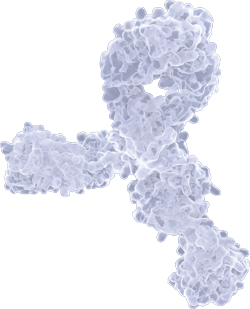 Introduction
Introduction
Determining optimal antibody concentration is an essential skill when performing reliable Western blot techniques. The optimal concentration must be re-evaluated every time a new primary or secondary antibody is used, or when experimental conditions change. Most antibodies come with a recommended concentration from the supplier, but no single antibody or antigen concentration will work for every experiment. The rate of binding between antibody and antigen (the affinity constant) is affected by: the amount of antigen in a sample; temperature; pH; and buffer constituents. The affinity constant of primary and secondary antibodies can also vary between manufacturers and batches. Therefore, re-optimization of the ideal antibody concentration is necessary to achieve the best possible results.
Many common problems can occur if the concentration of antigen, primary or secondary antibodies are too high or too low such as:
- No signal
- Weak signal
- Nonspecific bands (Ghost protein bands)
- Multiple bands at various MWs
- Blotched or speckled background
- Saturated band signal
- High background
- Brown/orange spots on membrane
- White (negative) bands on film
These problems can be resolved by optimizing the primary and secondary antibody concentrations via two possible methods. The most efficient and affordable option is to use the dot blot technique on a nitrocellulose membrane. The other option would be to perform antibody titration on a PVDF membrane. Unlike the dot blot technique, this approach may require performing multiple Western blots. However, the PVDF is easier to strip and reprobe with different antibody dilutions because it is more durable and resists the loss of protein sample better than nitrocellulose.
Dot Blot/Antibody Titration Protocol
Proteins are adhered to a nitrocellulose membrane (via dot blot) or PVDF membrane (via gel electrophoresis and transfer chamber) and then cut into strips that are used to screen combinations of serial dilutions of primary to secondary antibodies. For comparable results, it is important to keep all protocol parameters the same, such as sample type, incubation times, wash times and temperatures.
- Prepare the protein sample in the desired buffer. The protein sample should contain an abundance of the antigen of interest. Usually, the antigen concentration of a sample is unknown, so a wide range of dilutions may need to be tested.
- Cut a nitrocellulose membrane into 1cm strips, enough to test the number of primary and secondary antibody dilutions to be screened. Label the strips of antibody dilutions with pencil.
- If a PVDF membrane is used, then run the protein sample through gel electrophoresis and transfer to the PVDF membrane. Do not let the PVDF membrane dry out. Proceed to step 4.
- Dot the protein dilutions onto the dry nitrocellulose membrane strips using as little volume as possible for each dot (1-5 µl) so that sample does not spread across the membrane. To dot samples greater than 5µl, dot smaller volumes multiple times on the same spot allowing each dot to absorb and dry for 2-5 minutes. After dotting is complete, allow the strips to completely dry for 10-15 minutes.
- Block the membrane by incubating in blocking buffer for 1-2 hours at room temperature. Use a shaker to ensure even coverage of non-specific sites on the membranes.
- Incubate the membrane strips with the appropriate primary antibody dilution in washing buffer containing 10% volume of blocking buffer for 1 hour on an orbital shaker. The strips that are receiving the same concentration of primary antibody may be incubated together in the same bath.
- The typical starting primary antibody dilution is 1:1000, so test a series of 1:250, 1:500, 1:1000, 1:2000 and 1:4000 (0.2 to 5.0 µg/ml).
- If there is no recommended dilution then start with 1 µg/ml of purified antibody.
- Negative control samples with no primary or secondary antibodies should also be included to reveal non-specific cross-reactivity.
- The typical starting primary antibody dilution is 1:1000, so test a series of 1:250, 1:500, 1:1000, 1:2000 and 1:4000 (0.2 to 5.0 µg/ml).
- Wash the membrane strips thoroughly in wash buffer, 4 washes of 5 minutes.
- Incubate the membrane strips with the appropriate secondary antibody dilution in washing buffer containing 10% volume of blocking buffer for 1 hour on an orbital shaker. The strips that are receiving the same concentration of secondary antibody may be incubated together in the same bath.
- The typical starting secondary antibody dilution is 1:10,000, so test a series of 1:2,500, 1:5,000, 1:10,000, 1:20,000, and 1:40,000.
- Wash the membrane strips again, as in step 6
- Prepare the substrate working solution as described in the corresponding data sheet.
- Incubate the membrane strips with the substrate working solution for 5 minutes.
- Protect the membrane strips by placing them in a plastic wrap.
- Expose the wrapped strips protein side up against film. Exposure time can vary and will likely take longer for lower concentrations of primary/secondary antibody or if the membrane has aged past 24 hours. The resulting film of an optimized blot will clearly yield a band for your protein of interest with no background and no non-specific bands.
- If problems persist and a chemiluminescent substrate was used, then it is possible to strip and reprobe the membranes with adjusted dilutions of primary and secondary antibodies. Keep in mind that stripping does remove some sample protein from the membrane, especially nitrocellulose.






